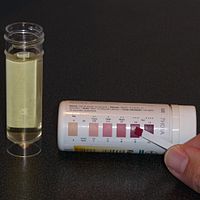
Photo from wikipedia
Voltage-gated sodium channels (VGSCs) are foundational to excitable cell function: Their coordinated passage of sodium ions into the cell is critical for the generation and propagation of action potentials throughout… Click to show full abstract
Voltage-gated sodium channels (VGSCs) are foundational to excitable cell function: Their coordinated passage of sodium ions into the cell is critical for the generation and propagation of action potentials throughout the nervous system. The classical paradigm of action potential physiology states that sodium passes through the membrane only transiently (1-2 milliseconds), before the channels inactivate and cease to conduct sodium ions. However, in reality, a small fraction of the total sodium current (1%-2%) remains at steady state despite prolonged depolarization. While this persistent sodium current (INaP) contributes to normal physiological functioning of neurons, accumulating evidence indicates a particularly pathogenic role for an elevated INaP in epilepsy (reviewed previously 1 ). Due to significant advances over the past decade of epilepsy research concerning the importance of INaP in sodium channelopathies, this review seeks to summarize recent evidence and highlight promising novel anti-seizure medication strategies through preferentially targeting INaP.
Journal Title: Epilepsy Currents
Year Published: 2020
Link to full text (if available)
Share on Social Media: Sign Up to like & get
recommendations!